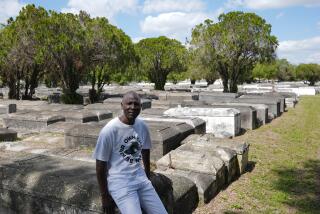Archeologists’ Dig Sheds Light on 19th-Century ‘Ultimate’ Slum and Its Dwellers : History: New York’s Five Points area was a deadly nest of squalor in the midst of the country’s most exuberant growth.
- Share via
NEW YORK — When Abraham Lincoln first visited New York in 1860, there were two things he wanted to see: a Brooklyn church famous for its abolitionist movement and Five Points, the country’s worst slum.
The church is still standing, but the section of lower Manhattan infamous as a “nest of vipers” for its crime and squalor was flattened around the turn of the century in a burst of reformist zeal.
Now archeologists are digging beneath two parking lots, hoping to unearth details about the poor immigrants who lived there for most of the 19th Century.
“This was the ultimate slum,” said James Shenton, a history professor at Columbia University. “Nothing in New York even remotely approaches it in terms of the depravity of the conditions of life.”
When the early settlers arrived, the area was marshland and contained a large freshwater pond. As the city grew, slaughterhouses, tanneries and other industries were established there, away from population centers.
In the depression of 1808, the city established a work relief project to drain the swamp, according to the WPA (Work Projects Administration) Guide to New York City. By virtue of its location, it became something of a recreational center for sailors and laborers.
But when underground springs caused the land to sink, the houses and taverns were abandoned to freed slaves and hordes of new Irish and German immigrants.
Small, dilapidated single-family homes were divided into three or four apartments, with entire families living in single rooms. Thousands of people lived in dark, dank cellars with dirt floors, prone to flooding.
“It became a place where anyone who couldn’t find a place to live would end up,” Shenton said.
Records from the 1870s describe one tenement with eight privies in the rear, where the ground was within a foot of the seats. Excrement seeped into the yard and ran under the basement apartment, a “veritable cesspool.”
In 1842, Charles Dickens toured the area, escorted by two policemen. “All that is loathsome, drooping and decayed is here,” he wrote in his “American Notes.”
Cholera epidemics hit Five Points at least twice, in 1832 and 1849.
Then as now, desperate conditions provided a breeding ground for crime.
In the mid-1800s, the city’s first gangs appeared there, with such names as the “Plug Uglies” and the “Dead Rabbits.” Murders were daily occurrences. Alcoholism was rampant; grocers sold spirits by the glass.
The most unsavory place was the “Old Brewery,” a converted tenement just off of “Murderers’ Alley.” Writers of the 1840s described it as a ruin that sheltered a thousand drunken men, all of whom were the worst criminal element.
Five Points was named for the odd configuration of the intersection of three streets, with Paradise Square--now the southwest corner of Columbus Park--at its center.
Today, the streets have either been built over or renamed. Almost all the tenements were razed and replaced by the park and government buildings.
Ironically, a few long-buried portions of the original tenements are seeing the light again--however briefly--because of the construction of two federal buildings.
A new courthouse is going up behind the current one on Foley Square, and a federal office building is slated for a parcel a few blocks away.
The 1966 National Historic Preservation Act mandates that any project receiving federal money be sensitive to its impact on historic properties.
Thus the General Services Administration hired an archeological firm to research the site and dig for any artifacts before excavation begins later this summer.
The archeological work accounts for about $125,000 of the $517-million cost of the two buildings, said Peter Sneed, director of the planning staff in the GSA’s Public Buildings Service in New York.
About a dozen archeologists from Historic Conservation and Interpretation Inc. of Newton, N.J., have been digging since early May.
At the courthouse site, workers have uncovered stone walls and brick stairways from the basements of slum buildings, which stand in jarring contrast to the modern architecture nearby.
In one section, five drain pipes stick up in a place where there was probably a “school sink,” a communal place to dump liquid refuse, said Ed Rutsch, head of the firm.
At the other site, human remains have been found, leading Rutsch to speculate that they may be close to an area marked on 18th-Century maps as the “Negroes Burying Ground.” During the Revolutionary War, the occupying British army also buried American prisoners of war there.
Workers sifting through the dirt also have uncovered pottery shards and remains of dinners long past.
Rutsch said that everything uncovered is examined, measured and photographed. Then, unless it’s unique and--more important--some institution agrees to accept and care for it, it will be cleared away.
“If it’s very unusual, we might talk to them about putting it in the hallway of the courthouse,” Rutsch said. “So far, I haven’t seen anything that would lend itself to that.”
Nevertheless, this dig is particularly interesting to archeologists, Rutsch said, because it offers them a glimpse into the daily lives of people on the bottom rungs of the social ladder, people about whom little was written.
Five Points--”That’s as common as you can get,” Rutsch said. “Now we’re getting one last look, and that’s great.”
More to Read
Sign up for Essential California
The most important California stories and recommendations in your inbox every morning.
You may occasionally receive promotional content from the Los Angeles Times.













